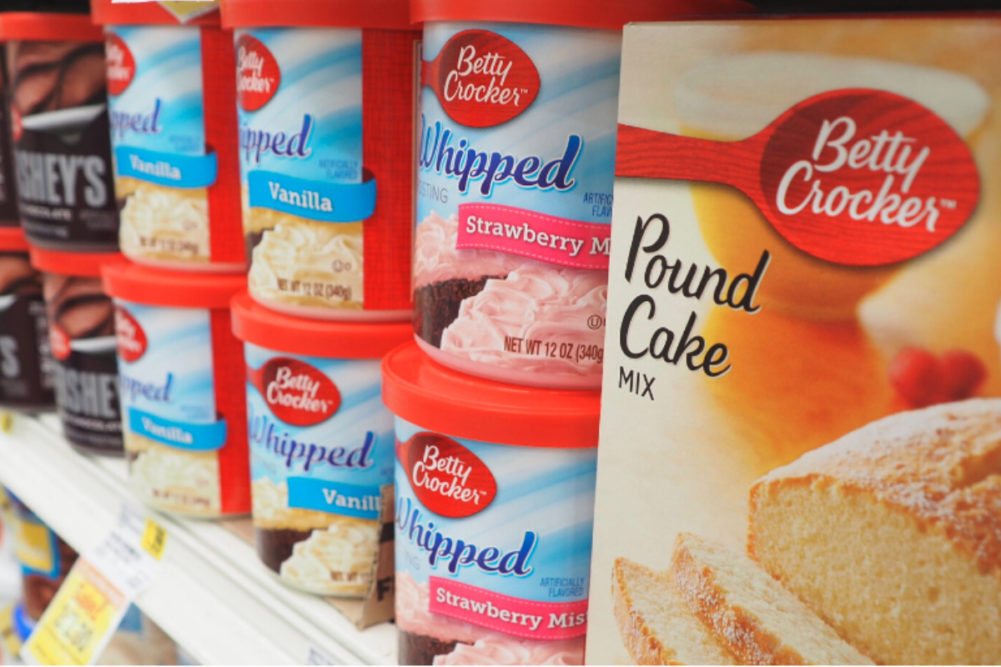MINNEAPOLIS — A common observation among executives of leading packaged foods companies in recent weeks is consumers in crisis embrace familiar brands. Jeffrey L. Harmening, chairman and chief executive officer of General Mills, Inc., said the company’s Betty Crocker, Pillsbury and Progresso businesses have benefited from this trend.
“The fact that General Mills has so many well-known brands, I think, serves us well right now,” Mr. Harmening said during a May 13 presentation as part of the BMO Capital Markets Farm to Market Conference. “But the other thing is that our products are available. I mean, our supply chain has been working well.”
The Minneapolis-based company on May 11 issued an update on its performance and outlook for the fiscal year ending May 31 reflecting stronger-than-anticipated at-home food demand in March and April. Management expects fourth-quarter organic net sales to increase by double digits over the prior-year period, and fourth-quarter constant-currency adjusted operating profit is expected to grow faster than organic net sales. The company said it expects to exceed each of its previous full-year financial targets of 1% to 2% organic net sales growth, 4% to 6% growth in constant-currency adjusted operating profit, and 6% to 8% growth in constant-currency adjusted diluted earnings per share.
The substantial decline in away-from-home food demand negatively impacts General Mills, but to a lesser degree than some of its competitors that have a stronger presence in foodservice channels. Globally, at-home food represents approximately 85% of General Mills’ net sales, and away-from-home food accounts for 15%.
“We're seeing improved growth across all of our categories, with the exception of our bars category,” Mr. Harmening said. “And we're seeing the same thing in Europe that we're seeing in the US on bars. But mostly that's because bars are eaten, to a large degree, on the go. And what we're seeing is consumption for food at home, particularly in our meals categories. And whether that meal is breakfast like cereal, whether it's lunch and dinner like Annie's macaroni and cheese or whether it's dinner occasions like Progresso or Totino's or Old El Paso, we're seeing the largest growth in our meals categories.
“In snacks, while the category has decelerated, we actually gained a little bit of share over the last two months in snack bars and aggregate. And so our competitive positioning has improved, even if the category hasn't gotten all the way back to health. And in yogurt, we're down a little bit on share so far this quarter. We're down about 30 basis points of share, which is what we were going in, even as we have seen the growth rate in yogurt improve.”
The impact of the pandemic on General Mills’ pet food business also was positive but less significant. A consumer stock-up in March propelled Blue Buffalo sales, but the category has decelerated rapidly since, Mr. Harmening noted, pointing out that “pets weren’t eating at restaurants before.”
“We actually saw in measured channels, the category declined (in April),” he said. “Blue Buffalo was still gaining share, but the category declined, and we wouldn't be surprised if we saw that again in May.”
The company has reduced the number of stock-keeping units it produces in several categories, such as soup, to simplify operations and meet the surge in at-home food demand. However, General Mills remains committed to releasing the new product innovations it had planned for the summer, Mr. Harmening said.
“As consumers stay at home and they've eaten the same thing for a few months on end, it occurs to us that perhaps something new might be a good idea for them,” he said. “The key, though, is to make sure we do that in a way that doesn't clog up either our distribution or manufacturing system or that of our customers. And so what you may see fewer new items from us, because the 150th item we're going to launch is probably not going to be a great idea in this environment. But the big launches, the big idea is the new big product innovations we will continue with this summer.”
Investments in e-commerce over the past five years are “really paying off now” as more consumers than ever purchase groceries online lately, Mr. Harmening said. Approximately 4.5% to 5% of General Mills’ US business was online prior to the pandemic. More recently, that percentage has jumped up to 6.5% to 7%, Mr. Harmening said.
“So, a meaningful increase in a very short period of time,” he said. “Now that means that still 94% or 93% is still through bricks and mortar. We haven't forgotten that either. But e-commerce has grown. We're advanced there. We don't need to make additional investments in things like packaging lines and other things to be competitive in e-commerce. And in our profitability and e-commerce channel is roughly what it is in other channels. And so we're excited about the growth of e-commerce, and we think it's a great opportunity for General Mills because we have leading brands because we have good capabilities.”
Mr. Harmening said the company is well-positioned for a post-pandemic economic recession, having competed effectively in the previous major financial downturn.
“To the extent that there's a recessionary period following the social isolation and to the extent that more people are working from home, we think that plays into the strength of General Mills, and particularly our categories around meals,” he said. “So think about Old El Paso and Progresso and Totino's and Pillsbury and our breakfast occasion where we're way over-indexed with breakfast cereal, that plays into our wheelhouse.”






